Introduction
We are synthesizing XUV attosecond beams with original properties, in particular carrying various angular momentum, and developing specific associated applications.
As with matter, two forms of angular momentum are traditionally distinguished when associated with light: spin angular momentum, associated with the circular polarization of light, and orbital angular momentum, associated with the helical shape of the wavefront.

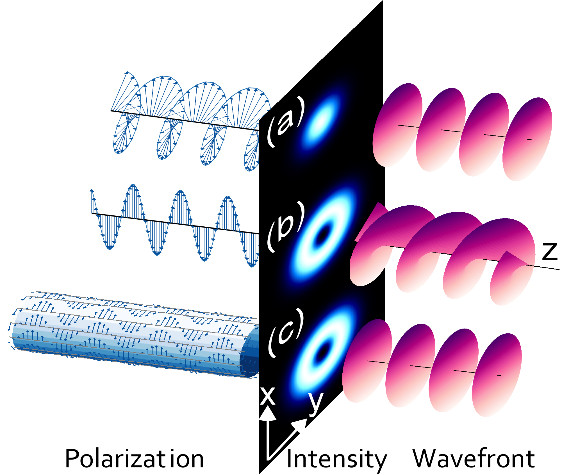
Attosecond physics has been built on the use of angular momentum-free beams: essentially Gaussian, with a flat wavefront, uniform polarization and generally linear.
We are exploring the possibility of breaking out of this straitjacket, by creating a variety of structurations of attosecond XUV light and developing their applications.
Research hypothesis
At the core of our research is the upconversion process by which a femtosecond intense infrared laser field is converted into a series of odd harmonics of its fundamental frequency. We focus ourselves on the High Harmonics Generation process (HHG) in gases. It yields a very broad harmonic comb that extends in the XUV region of the spectrum. First, we use it to synthetize attosecond pulses, i.e. light pulses whose duration is in the the 10 -18 s range.
Second, these harmonics combs or attosecond pulses are used to study photoionization or transient reflectivities in pump/probe schemes, where one beam is the remaining IR from the upconversion process.
Our research hypothesis is that HHG is an ideal playground to investigate angular-momentum behavior in non linear processes, and will offer unprecedented capabilities to these cutting-edge attosecond sources for applications.
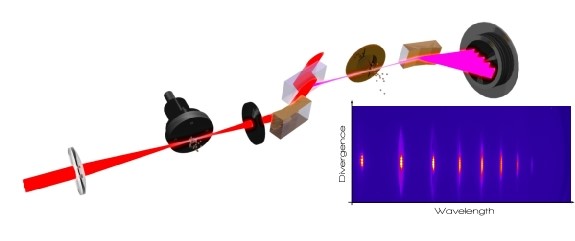
XUV beams carrying an orbital angular momentum
Like any massive particle, photons may carry both a spin and an orbital angular momentum. The former is associated to the circular polarisation of a light beam, while the latter is associated to an helicoidal wavefront (see for instance the review by A. M. Yao and M. J. Padgett).
A basis of light beams showing orbital angular momentum, solutions of the paraxial wave equation, are the Laguerre Gaussian beams (see e.g. the presentation by D. Dounas-Frazer).
Read more
These two types of beams find applications in different situations. In particular, while the spin projection along the propagation axis for paraxial beams is limited to two values, ±ℏ, the orbital angular momentum can take any positive or negative integer value.
This leads to capabilities of much denser encoding of information on light beams. For spectroscopic outlooks and imaging outlooks in particular, having at hand XUV beams carrying orbital angular momentum would be invaluable. It is also an ideal situation to test conservation laws derived from quantum mechanics.
We managed to transfer an orbital angular momentum from a visible light beam to the XUV using the high harmonic generation process. These beams have an helicoidal wavefront associated to an azimutal phase. The phase singularity in the center of the beam leads to a zero of intensity, explaining their “donut” shape.
We could also measure their “topological charge” and verify the conservation law: harmonic q carries q times the orbital angular momentum of the driving laser. Finally, we could measure their spatio-temporal structure, showing a double helix pattern. Through a collaboration with the group of Giovanni de Ninno , we could generalized this transfer law to the case of HHG with two beams.
See also the press release on the CEA website Géneaux et al.
Géneaux et al,Nature Communications, Aug, 2016. Vol. 7, 12583
Gauthier et al, Nature Communications, 2017, Vol. 8, 14971
Géneaux et al.,Phys. Rev. A, 2017, Vol. 95, 051801
Camper et al,Optics Letters, 2017, Vol. 42, 3769
In a side experiment with the group of Lou Di Mauro, we could generate very intense MidIR ultrashort laser pulses carrying OAM, directly in an OPA stage. This may open the way to direct synthesis of very high harmonics carrying OAM. More recently, on FERMI-FEL we demonstrated the enhanced capabilities of OAM beams for imaging. Using a ptychographic approach a 30% increase of image resolution compared to regular Gaussian beam was achieved at λ=18.9 nm, achieving a 85 nm resolution.
Further information: Ligne de lumière nanolite, High-resolution ptychographic imaging at a seeded free-electron laser source using OAM beams
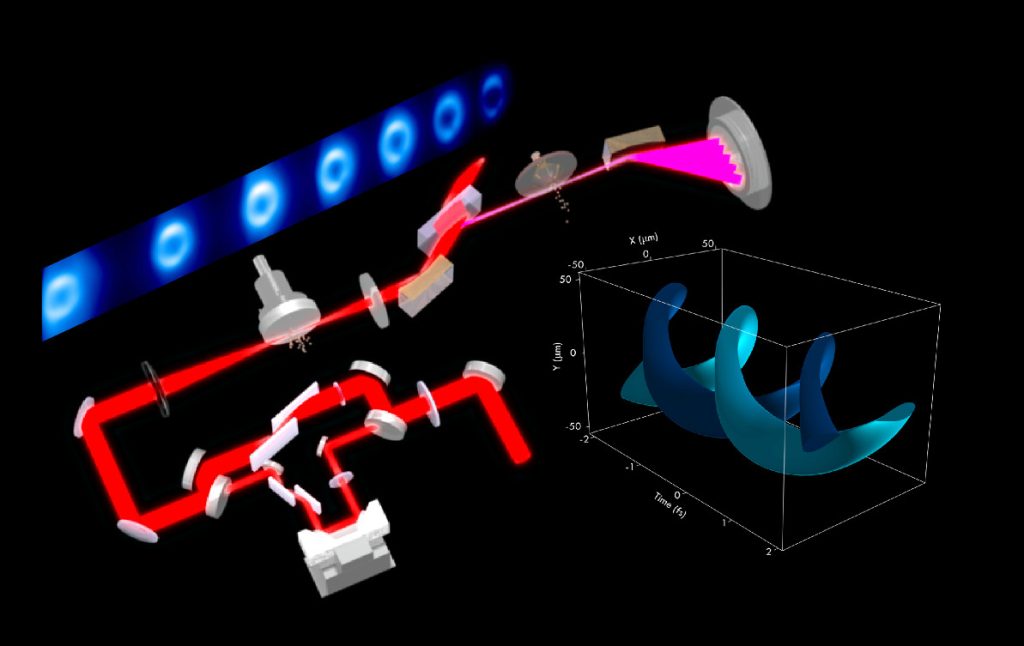
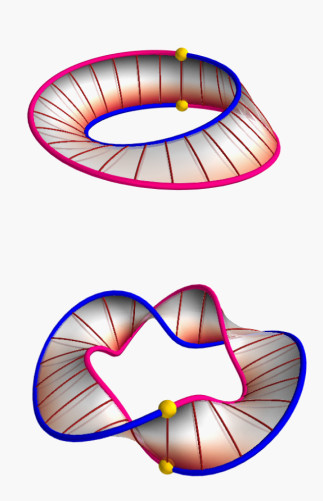
A Polarization Möbius strip
Beyond OAM and SAM, it was lately noticed that light beams may present a topologically non-trivial structure, in which the two types of angular momentum (SAM and OAM) are entangled: the photon’s state is no longer an eigenvector of neither the spin nor orbital angular momentum operators (SAM and OAM), but of a new operator, a linear combination of SAM and OAM, called Generalized Angular Momentum (GAM).
Interestingly, while the eigenvalues of SAM and OAM are integers, the GAM, a combination of (OAM +1/2 SAM), has half-integer eigenvalues. The unresolved question was the role of this new quantity in light-matter interactions: a mere mathematical construct or a quantity as fundamental as spin and orbital angular momenta?
Experimentally, laser beams possessing a ‘Möbius strip polarization’ structure and carrying a GAM of ℏ/2 have been generated at the ATTOLab facility of LIDYL, and used to produce high-order harmonics (HHG).
Read more
A detailed study of the structure of the generated harmonics shows that the fractional angular momentum of the fundamental infrared beam is transferred to these harmonics in the extreme ultraviolet, and the Möbius strip structure is preserved during the conversion.
The photons of the harmonic of order q carry a GAM of qℏ/2, and their OAM and SAM are entangled. Therefore, the GAM appears as a perfectly valid angular momentum of light, just like OAM and SAM. From now on, it can be manipulated in the same way in nonlinear light-matter interaction experiments.
We are currently building on this first demonstration to expend even further our shaping capabilities, and find applications to these beams.
To find out more: Non-linear optics with a light beam carrying a half-integer angular momentum (Möbius strip polarization)
Related publication:
“Nonlinear up-conversion of a polarization Möbius strip with half-integer optical angular momentum“
Magnetic Helical Dichroism
Although available for over 30 years in the visible domain, beams with OAM in the XUV spectral range were only observed and made available in the past decade. And they have scarcely been used in XUV spectroscopy thus far.
As such, while magneto-optical diagnosis such as Faraday Effect and Magnetic Circular Dichroism, which build on the Spin Angular Momentum of light; are widespread on XUV beamlines, no corresponding magnetic spectroscopy based on OAM had been investigated or proposed thus far.
We wondered whether, in the linear regime, OAM beams could provide a specific signature when reflected on a magnetic structure. These structures are widely studied using the polarization of light, via the magneto-optical Kerr effect or the Faraday effect (Read more : Attosecond spectroscopy of materials) .
We extended the formalism describing these effects to the case of beams carrying orbital angular momentum and inhomogeneous targets; and identified a ‘helical magnetic dichroism.’
Read more
A collaboration involving researchers from eight institutions, which we coordinated, revealed this effect in 2021. The chosen magnetic sample, made of permalloy, has a vortex-shaped magnetization whose rotation direction is determined by the magnetic field during the initial magnetization of the layer.
It is placed at the focus of the DIPROI experimental setup, receiving the beam from the FERMI free-electron XUV laser (Elettra) in Trieste, Italy. The laser pulse duration is on the order of a few tens of femtoseconds, and the reflected beam forms a far-field image that exhibits a chiral asymmetry, indicating the presence of polarized vortices. The direction of the image (right or left) depends on the vortex rotation direction and the OAM (see figure).
This first demonstration is currently being explored further, both theoretically and using a harmonic source from ATTOLab.”
Read more
Further information: First observation of magnetic helical dichroism in vortex structures
Related publications :
“Electromagnetic theory of helicoidal dichroism in reflection from magnetic structures“,
M. Fanciulli, D. Bresteau, M. Vimal, M. Luttmann, M. Sacchi, and T. Ruchon, Physical Review A, 103 (1) (2021) 013501.
“Observation of magnetic helicoidal dichroism with extreme ultraviolet light vortices“,
M. Fanciulli, M. Pancaldi, E. Pedersoli, M. Vimal, D. Bresteau, M. Luttmann, D. De Angelis, P. R. Ribič, B. Rösner, C. David, C. Spezzani, M. Manfredda, R. Sousa, I.-L. Prejbeanu, L. Vila, B. Dieny, G. De Ninno, F. Capotondi, M. Sacchi, and T. Ruchon, Physical Review Letters, 128 (2022) 077401.

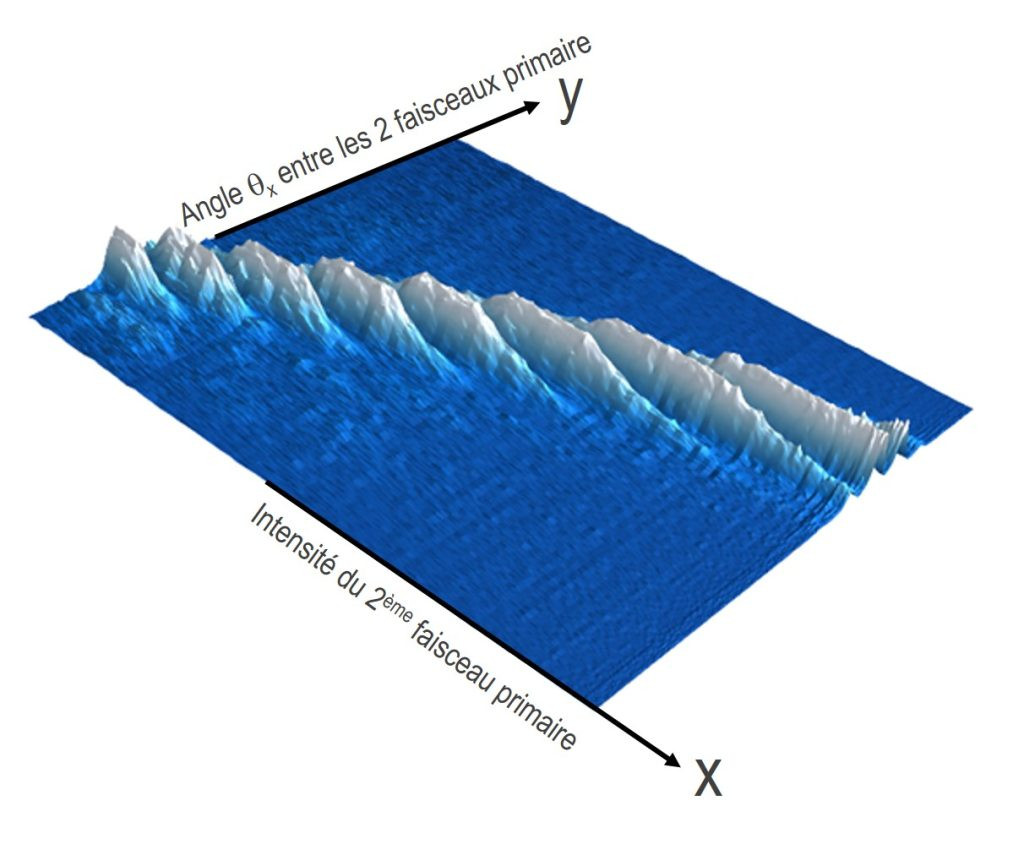
High Harmonic Generation with two beams
Our efforts to control the angular momentum of the beams produced by HHG (High Harmonic Generation) led us to use multiple driving beams, crossing at an angle in the HHG medium.
It was known that in this situation, multiple harmonic sub-beams are emitted. For harmonic q, they correspond to the absorption of q-n photons from the first beam and n photons from the second beam. As such, the energy of the outgoing photon is still qℏω, but its propagation direction reads (q-n) k1+ n k2; k1and k2 being the wavevectors of the two driving beams.
Read more
We first showed that, in addition to the conservation of energy and momentum, orbital angular momentum was also conserved in this process (see above). However, the yield of each sub-beam as a function of the relative intensity of the two drivers resisted interpretation.
To recombine this photon picture and the more standard field-based approach to HHG, we carried out a series of experiments demonstrated that the generation of a given harmonic results from the coherent addition of several interfering processes: beyond the minimum number of photons required to produce a given harmonic, each channel involves one or more extra photon pairs, associated with the combination of an equal number of absorptions and stimulated emissions.
A very simple model, counting the different contributing paths, allowed us to account for the experimental results. This result offers a new point of view to the HHG process, from the photon perspective, to be harnessed in quantum attosecond optics.
Related publications :
“Photon pathways and the non-perturbative scaling law of high harmonic generation“
Mekha Vimal, Martin Luttmann, Titouan Gadeyne, Matthieu Guer, Romain Cazali, David Bresteau, Fabien Lepetit, Olivier Tcherbakoff, Jean-François Hergott, Thierry Auguste, and Thierry Ruchon, Phys. Rev. Lett. 131 (2023) 203402.
“Nonperturbative transverse mode coupling in high-order harmonic generation“
Martin Luttmann, Mekha Vimal, Matthieu Guer, Titouan Gadeyne, Céline Chappuis, Jean-François Hergott, and Thierry Ruchon, Phys. Rev. A 108 (2023), 053509.
“Photonic Picture of High Harmonics“
Further information: Photonic decomposition of high-order harmonics in strong fields


